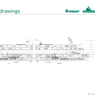BP and Invensys Tackle Bunker Fuel Problem
BP asked the three flow meter manufacturers to take part in a laboratory trial to determine the ability of their flow meters to accurately measure bunker oil. The criterion of the test was to measure the amount of oil by mass excluding any suspended air. The only product that was able to meet this strict criterion was the Foxboro CFT50 Digital Coriolis Meter, which was developed by Invensys in partnership with Oxford University. With over 200 million tons of bunker fuel delivered to ships each year, it is essential that the process of delivering bunkers is both fair and safe. This project proposes technology as the solution: not only can the delivered mass be accurately measured, but by use of the latest communications technology, the ship’s crew can “see” the fuel delivery data in real time without the need to climb down onto the barge, (a hazardous activity which has resulted in a number of fatalities). But bunkering is a wide-ranging activity, with stems (fuel deliveries) ranging from 300 tons to 12,000 tons. Flow rates vary, timing is often critical (to meet tides, for example) and the value of some deliveries can exceed millions of dollars. The measurement quality issue is of equal concern both to ship operators and to the International Bunkering Industry Association, (IBIA). Raising industry standards is one of the current themes of IBIA, who will be overseeing the setting of a new measurement standard for the global bunker industry.












